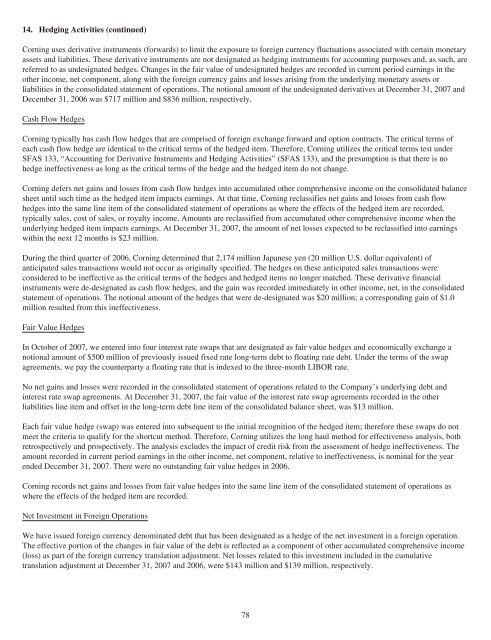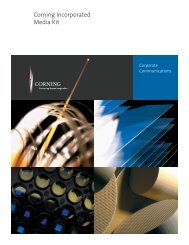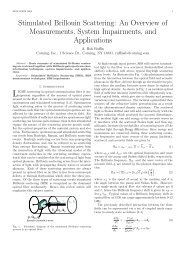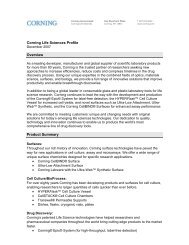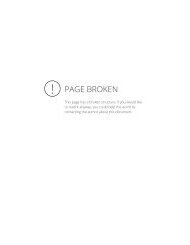Create successful ePaper yourself
Turn your PDF publications into a flip-book with our unique Google optimized e-Paper software.
14. Hedging Activities (continued)<br />
<strong>Corning</strong> uses derivative instruments (forwards) to limit the exposure to foreign currency fluctuations associated with certain monetary<br />
assets and liabilities. These derivative instruments are not designated as hedging instruments for accounting purposes and, as such, are<br />
referred to as undesignated hedges. Changes in the fair value of undesignated hedges are recorded in current period earnings in the<br />
other income, net component, along with the foreign currency gains and losses arising from the underlying monetary assets or<br />
liabilities in the consolidated statement of operations. The notional amount of the undesignated derivatives at December 31, <strong>2007</strong> and<br />
December 31, 2006 was $717 million and $836 million, respectively.<br />
Cash Flow Hedges<br />
<strong>Corning</strong> typically has cash flow hedges that are comprised of foreign exchange forward and option contracts. The critical terms of<br />
each cash flow hedge are identical to the critical terms of the hedged item. Therefore, <strong>Corning</strong> utilizes the critical terms test under<br />
SFAS 133, “Accounting for Derivative Instruments and Hedging Activities” (SFAS 133), and the presumption is that there is no<br />
hedge ineffectiveness as long as the critical terms of the hedge and the hedged item do not change.<br />
<strong>Corning</strong> defers net gains and losses from cash flow hedges into accumulated other comprehensive income on the consolidated balance<br />
sheet until such time as the hedged item impacts earnings. At that time, <strong>Corning</strong> reclassifies net gains and losses from cash flow<br />
hedges into the same line item of the consolidated statement of operations as where the effects of the hedged item are recorded,<br />
typically sales, cost of sales, or royalty income. Amounts are reclassified from accumulated other comprehensive income when the<br />
underlying hedged item impacts earnings. At December 31, <strong>2007</strong>, the amount of net losses expected to be reclassified into earnings<br />
within the next 12 months is $23 million.<br />
During the third quarter of 2006, <strong>Corning</strong> determined that 2,174 million Japanese yen (20 million U.S. dollar equivalent) of<br />
anticipated sales transactions would not occur as originally specified. The hedges on these anticipated sales transactions were<br />
considered to be ineffective as the critical terms of the hedges and hedged items no longer matched. These derivative financial<br />
instruments were de-designated as cash flow hedges, and the gain was recorded immediately in other income, net, in the consolidated<br />
statement of operations. The notional amount of the hedges that were de-designated was $20 million; a corresponding gain of $1.0<br />
million resulted from this ineffectiveness.<br />
Fair Value Hedges<br />
In October of <strong>2007</strong>, we entered into four interest rate swaps that are designated as fair value hedges and economically exchange a<br />
notional amount of $500 million of previously issued fixed rate long-term debt to floating rate debt. Under the terms of the swap<br />
agreements, we pay the counterparty a floating rate that is indexed to the three-month LIBOR rate.<br />
No net gains and losses were recorded in the consolidated statement of operations related to the Company’s underlying debt and<br />
interest rate swap agreements. At December 31, <strong>2007</strong>, the fair value of the interest rate swap agreements recorded in the other<br />
liabilities line item and offset in the long-term debt line item of the consolidated balance sheet, was $13 million.<br />
Each fair value hedge (swap) was entered into subsequent to the initial recognition of the hedged item; therefore these swaps do not<br />
meet the criteria to qualify for the shortcut method. Therefore, <strong>Corning</strong> utilizes the long haul method for effectiveness analysis, both<br />
retrospectively and prospectively. The analysis excludes the impact of credit risk from the assessment of hedge ineffectiveness. The<br />
amount recorded in current period earnings in the other income, net component, relative to ineffectiveness, is nominal for the year<br />
ended December 31, <strong>2007</strong>. There were no outstanding fair value hedges in 2006.<br />
<strong>Corning</strong> records net gains and losses from fair value hedges into the same line item of the consolidated statement of operations as<br />
where the effects of the hedged item are recorded.<br />
Net Investment in Foreign Operations<br />
We have issued foreign currency denominated debt that has been designated as a hedge of the net investment in a foreign operation.<br />
The effective portion of the changes in fair value of the debt is reflected as a component of other accumulated comprehensive income<br />
(loss) as part of the foreign currency translation adjustment. Net losses related to this investment included in the cumulative<br />
translation adjustment at December 31, <strong>2007</strong> and 2006, were $143 million and $139 million, respectively.<br />
78


